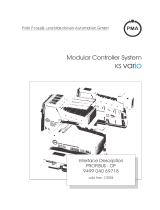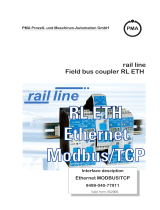Page is loading ...

Modular C0NTR0L system
KS vario
CAN o
p
en
INTERFACE protoCol
9499 040 69911
VALID FR0M 09/2005

KSvario CANopen interface protocol
2 9499 040 69911 Preliminary
BlueControl® is a registered trademark of
PMA Prozeß- und Maschinen-Automation GmbH
©PMA Prozeß- und Maschinen-Automation GmbH. Printed in Germany.
All rights reserved. No part of this document may be reproduced
or published in any form or by any means without prior written
permission by the copyright owner.
This is a publication of PMA Prozeß- und Maschinen-Automation GmbH.
Data is subject to change without notice.
PMA Prozeß- und Maschinen-Automation GmbH
P.O. Box 31 02 29
D 34058 Kassel
Germany
Limitation of warranty:
No warranty is given for the absolute correctness of this manual, because despite utmost care,
errors can never be avoided entirely. Hints are always welcome and will be gratefully accepted.

KSvario CANopen interface protocol
Preliminaryg 9499 040 69918 3
Table of contents Page
1. Introduction........................................................................................................................................................ 4
1.1 General ......................................................................................................................................................... 4
1.2 Technical data............................................................................................................................................... 4
1.3 Predefined Master/Slave Connection Set ..................................................................................................... 5
1.4 Commissioning the KSvario in the CANbus .................................................................................................. 6
2. Service Data Objects (SDO).............................................................................................................................. 7
3. Process Data Objects (PDO)............................................................................................................................. 9
3.1 Application .................................................................................................................................................... 9
3.2 Setting the communication parameters for ‘Receive PDOs’.......................................................................... 9
3.3 Setting the communication parameters for ‘Transmit PDOs’....................................................................... 10
3.4 Adjusting the mapping parameters of the PDOs ......................................................................................... 13
3.5 Reading the mapping parameters via CANbus ........................................................................................... 18
4. NMT services .................................................................................................................................................. 19
5. SYNC .............................................................................................................................................................. 20
6. LSS services ................................................................................................................................................... 21
6.1 Switch mode protocols ................................................................................................................................21
6.2 Configuration protocols ............................................................................................................................... 22
6.3 Inquiry protocols.......................................................................................................................................... 23
6.4 Identification Protocols ................................................................................................................................24
7. Saving and loading parameters (Store/Restore) ............................................................................................. 25
7.1 Non-volatile saving of parameters (Index 0x1010) ...................................................................................... 25
7.2 Loading saved parameters (Index 0x1011)................................................................................................. 25
8. Heartbeat......................................................................................................................................................... 25
8.1 Configuration as Heartbeat Producer (Index 0x1017): ................................................................................ 25
8.2 Configuration as Heartbeat Consumer (Index 0x1016): .............................................................................. 25
9. Configuration and parametrising via the CANbus............................................................................................ 26
10. CAN physical layer...................................................................................................................................... 28
10.1 ISO 11898-2 nodes ..................................................................................................................................... 28
10.2 Bitrates and bus lengths.............................................................................................................................. 29
10.3 Practical bus lengths ................................................................................................................................... 29
10.4 Cable parameters........................................................................................................................................ 30

KSvario CANopen interface protocol
4 9499 040 69911 Preliminary
1. Introduction
1.1 General
The KSvario is fitted with a CAN interface that is used to transmit all the data required for the
controller's operation (parameters and configuration data). Similarly, a corresponding master
device (PLC or industrial PC) can be given access to all process data.
In accordance with the CANopen standard, data transmission is structured in SDO (Service Data
Objects) and PDO (Process Data Objects). Hereby, SDOs are intended for configuring and
parametrizing bus subscribers, whilst PDOs are used for the usual operating values.
The communication services implemented in the KSvario are based on the CANopen Application
Layer and Communication Profile (CiA Draft Standard 301).
1.2 Technical data
• 2 SDO channels
• 4 Transmit PDOs (TPDO), synchronous/asynchronous
• 4 Receive PDOs (RPDO), asynchronous
• Mapping of PDOs
• Standard operation
• Multiplex operation with channel-wise transmission
• Multiplex operation with indexed transmission
• Data format: Float, Fixpoint 1, and Integer
• Transmission speeds from 10 kbit/s up to 1 Mbit/s
• NMT services
• LSS services
• Heartbeat
• Store/Restore
• Predefined Master/Slave Connection Set

KSvario CANopen interface protocol
Preliminaryg 9499 040 69918 5
1.3 Predefined Master/Slave Connection Set
The Communication Object Identifiers (COB-IDs) in the KSvario are assigned in accordance with
the Predefined Master/Slave Connection Set. Exceptions hereby are the PDOs – special
settings permit deviations from the Connection Set.
Object Function code COB-ID range Index in Object directory
Broadcast messages
NMT 0000 0 -
Sync 0001 0x80 0x1005h
Point-to-point messages
TPDO1 0011 0x181-0x0x1FF 0x1800
RPDO1 0100 0x201-0x27F 0x1400
TPDO2 0101 0x281-0x2FF 0x1801
RPDO2 0110 0x301-0x37F 0x1401
TPDO3 0111 0x381-0x3FF 0x1802
RPDO3 1000 0x401-0x47F 0x1402
TPDO4 1001 0x481-0x4FF 0x1803
RPDO4 1010 0x501-0x57F 0x1403
Default TSDO 1011 0x581-0x5FF 0x1200
Default RSDO 1100 0x601-0x67F 0x1200
LSS 1111 0x7E4/0x7E5

KSvario CANopen interface protocol
6 9499 040 69911 Preliminary
1.4 Commissioning the KSvario in the CANbus
When delivered, the device node address is 255, and the bitrate is set to 20 kbit/s. The node
address 255 starts the device in the LSS mode. If this not desired, any node address in the
range from 1 to 127 can be selected. These settings can be carried out with the help of the
BlueControl® via the BlueControl® interface, or by means of the LSS services via the CANbus.
When the KSvario has been started (with valid node address), it enters the "pre-operational
mode". Communication is possible via the CAN interface by means of SDOs. After configuring
the bus and the device, the Master must switch the KSvario into the "operating mode" (NMT
start), so that PDOs can also be used.
The manner, in which PDOs are to be used, must be configured in advance. Hereby, a
distinction is made between "asynchronous PDOs" and "synchronous PDOs".
Asynchronous PDOs are transmitted in case of changed process values.
Synchronous PDOs are transmitted on demand by the Master. For this, the Master transmits a
SYNC frame.

KSvario CANopen interface protocol
Preliminaryg 9499 040 69918 7
2. Service Data Objects (SDO)
An SDO is defined logically for exactly two partners: 1 Master and 1 Slave. As the KSvario has
two SDO channels, it is possible to access the KSvario simultaneously from two different SDO
Masters. Data transmission via SDO is a confirmed service.
By means of the SDOs, controller configuration and parametrising can be done using single
accesses. But also all operating data, which are usually transmitted via PDOs, can be addressed
via SDOs.
The COB-ID used is determined by the selected device address:
For the Transmit SDO, this value lies in the range of 1409 – 1535 (0x581 – 0x5FF).
For the Receive SDO, it lies in the range of 1537 – 1663 (0x601 – 0x67F)
The 2nd SDO channel can be adjusted by means of BlueControl®. In the example shown, the 2nd
SDO channel is activated, and the CANbus address 112 is used, so that the COB-IDs 1520
(0x5f0) and 1648 (0x670) are used. The addresses of both SDO channels must be different.
The COB-ID of the 1st SDO channel is defined by the selected node address (predefined
connection set).
Alternatively, a configuration via CANbus is possible. It is carried out using the objects with the
Index/Subindex 0x1201/1 and 0x1201/2 respectively.
Device-specific commands, such as change of operating mode (pre-operational mode, operating
mode, etc.), can only be executed via the 1st SDO channel.

KSvario CANopen interface protocol
8 9499 040 69911 Preliminary
Max. 4 bytes of user data can be transmitted by SDOs. The remaining 4 bytes are used as
follows:
1 byte for the command: type of transmission
2 bytes for the index: object detection (e.g. 0x2476 for setpoint)
1 byte for the subindex: channel number
In the following, one example each of SDO data frames for reading and writing is given.
Example 1: A Master transmits a setpoint to a KSvario with node address 4
The message is structured as follows:
COB_ID = SDO to node 4 = 0x600 + 4 = 0x604
CMD = write access = 0x2B = 0x2B
INDEX = setpoint = 0x2476 = 0x2476
SUBINDEX = e.g. controller 1 = 01 = 0x01
VALUE = 30,0°C *) = 300 *) = 0x12C
*) Representation as Fixpoint 1, i.e. 1 fixed decimal place.
8 data bytes
COB-ID LEN Cmd Index Sub. Data
Request (Master) 0x604 0x08 0x2B 0x76 0x24 0x01 0x2c 0x01 0x00 0x00
Reply (KSvario) 0x584 0x08 0x60 0x76 0x24 0x01 0x00 0x00 0x00 0x00
Example 2: A Master reads a process value from a KSvario with node address 2
The message is structured as follows:
COB_ID = SDO to node 2 = 0x600 + 2 = 0x602
CMD = read access = 0x40 = 0x40
INDEX = setpoint = 0x2441 = 0x2441
SUBINDEX = e.g. controller 3 = 03 = 0x03
8 data bytes
COB-ID LEN Cmd Index Sub. Data
Request (Master) 0x602 0x08 0x40 0x41 0x24 0x03 0x00 0x00 0x00 0x00
Reply (KSvario) 0x582 0x08 0x4B 0x41 0x24 0x03 0xFA 0x00 0x00 0x00
VALUE = 0x00FA = 250 = 25,0°C

KSvario CANopen interface protocol
Preliminaryg 9499 040 69918 9
3. Process Data Objects (PDO)
The KSvario provides 4 ‘Receive PDOs’ (RPDOs) and 4 ‘Transmit PDOs’ (TPDOs).
PDOs are unconfirmed services with max. 8 bytes of user data.
All incoming messages are processed in the sequence of their arrival. Preferential treatment of
special messages is not possible.
Transmitting and receiving of PDOs is only possible in the operating mode.
3.1 Application
For example, data transfer via PDOs makes sense if the process values and status values from
the controller are to be updated continuously in the Master. In this case, asynchronous PDOs
will be used, which automatically transmit any changed values from the controller to the
respective Master. Another example would be the cyclical request for process values from an
operating unit. In this case, the KSvario can transmit PDOs that are synchronized with a
measuring cycle (SYNC EVENT).
3.2 Setting the communication parameters for ‘Receive PDOs’
Only the COB-ID needs to be adjusted for the Receive PDO (RPDO). In general, a COB-ID from
the range 385 – 1407 (0x181 – 0x57F) can be used for the PDO.
In the predefined connection set, the selected device address is used to define the COB-ID.
With a device address 5, the following COB-IDs apply:
• RPDO1 517 (0x205)
• RPDO2 773 (0x305)
• RPDO3 1029 (0x405)
• RPDO4 1285 (0x505)
The KSvario can only receive PDOs asynchronously.
3.2.1. Settings for ‘Receive PDO’ via CANbus
Settings via CANbus are executed by means of the following objects:
• RPDO1 via Index 0x1400 and Subindex 1.
• RPDO2 via Index 0x1401 and Subindex 1.
• RPDO3 via Index 0x1402 and Subindex 1.
• RPDO4 via Index 0x1403 and Subindex 1.
If the most significant bit of the 32-bit datum is set, the RPDO is not active.

KSvario CANopen interface protocol
10 9499 040 69911 Preliminary
3.2.2. Settings for ‘Receive PDO’ via the BlueControl® Engineering Tool
In the example shown, RPDO 1 is activated. Because the COB-ID is disabled, the device uses
the predefined connection set, which is 517 (0x205) in this case for a selected device address 5.
If an own COB-ID is to be selected, the corresponding entry must be activated with a tick in the
column ‘on’. Subsequently, a number in the range of 385 – 1407 must be entered in the column
‘Value’.
3.3 Setting the communication parameters for ‘Transmit PDOs’
The following values must be entered for the Transmit PDO (TPDO):
• COB-ID
Usually, a COB-ID from the range 385 – 1407 (0x181 – 0x57F) can be used for the PDO.
In the predefined connection set, the selected device address is used to define the COB-ID.
The following COB-IDs are valid for a device address 5:
- TPDO1 389 (0x185)
- TPDO2 645 (0x285)
- TPDO3 901 (0x385)
- TPDO4 1157 (0x485)

KSvario CANopen interface protocol
Preliminaryg 9499 040 69918 11
• Synchronous / asynchronous operation
– 1 – 240 synchronous. The device generates a TPDO after receiving the 1st or 240th
SYNC signal.
– 255 asynchronous. The device generates a TPDO if a value has changed in the
TPDO to be transmitted.
• Inhibit Time
Determines the minimum time before the next TPDO can be generated. To prevent very
many messages being generated in case of fast changes of the values in the TPDO, the
Inhibit Time can be used to define a delay time. Adjustment is done in increments of 0,1 ms.
If the value is set to 0, there is no delay.
• Event Timer
Determines the maximum delay time before the next TPDO is generated, also if there has
been no change of value. Adjustment is done in increments of 1 ms. If the value is set to 0,
automatic transmission is disabled. If multiplexed data are transmitted (channel-wise or per
Index), the Event Timer is not active.
3.3.1. Settings for ‘Transmit PDO’ via CANbus
Settings via CANbus are executed by means of the following objects:
• COB-ID
- TPDO1 via Index 0x1800 and Subindex 1.
- TPDO2 via Index 0x1801 and Subindex 1.
- TPDO3 via Index 0x1802 and Subindex 1.
- TPDO4 via Index 0x1803 and Subindex 1.
If the most significant bit of the 32-bit datum is set, the TPDO is not active.
• Synchronous / asynchronous operation
- TPDO1 via Index 0x1800 and Subindex 2.
- TPDO2 via Index 0x1801 and Subindex 2.
- TPDO3 via Index 0x1802 and Subindex 2.
- TPDO4 via Index 0x1803 and Subindex 2.
• Inhibit Time
- TPDO1 via Index 0x1800 and Subindex 3.
- TPDO2 via Index 0x1801 and Subindex 3.
- TPDO3 via Index 0x1802 and Subindex 3.
- TPDO4 via Index 0x1803 and Subindex 3.
• Event Timer
- TPDO1 via Index 0x1800 and Subindex 5.
- TPDO2 via Index 0x1801 and Subindex 5.
- TPDO3 via Index 0x1802 and Subindex 5.
- TPDO4 via Index 0x1803 and Subindex 5.
Subindex 4 is not used.

KSvario CANopen interface protocol
12 9499 040 69911 Preliminary
3.3.2. Adjustment for ‘Transmit PDO’ via BlueControl®
In the example shown, TPDO 2 is activated.
The fixed address 385 (0x181) has been assigned as COB-ID.
This is an asynchronous PDO. The Inhibit Time has been set to 1 second, so the next TPDO
cannot be generated before this delay time has elapsed.
The Event Timer is set to 25 sec. Therefore, a TPDO is generated after 25 seconds at the latest,
even if no value has changed.

KSvario CANopen interface protocol
Preliminaryg 9499 040 69918 13
3.4 Adjusting the mapping parameters of the PDOs
3.4.1. General information on adjustment of mapping parameters
The mapping parameters define which data are to be communicated in the PDOs. These
parameters can only be adjusted via BlueControl®. Reading via the CANbus is possible.
Only parameters and signals can be used. The data of RPDOs must be writable data. By means
of the selection options, BlueControl® ensures that these conditions are fulfilled.
Data can be transmitted both in the Integer as well as the Float format. Data that are transmitted
in the Integer format, but are processed in the device as Float values, are transmitted as Fixpoint
1 data (value is multiplied with factor 10).
The quantity of data that can be transmitted in a PDO depends on the data type (Integer or Float
format) as well as the transmission method (standard or multiplex operation). If too many data
are selected, their entries are marked in red colour. These selected data will not be transmitted
to the device by BlueControl®.
There are various possibilities of transmitting data in a PDO.
3.4.2. Standard operation
In this mode, fixed SDO parameters are assigned to the PDO. They are determined by the SDO
parameter, and in addition by the subindex, if the data originates from the channel area. The
data length depends on whether they have been selected from the Integer range 0x2000 (2
bytes) or from the Float range 0x3000 (4 bytes). A combination of 2-byte and 4-byte data is
possible. Therefore, max. 4 items of data can be transmitted in the 8 bytes provided by a PDO.
Not all the bytes of the PDO must be used.
Integer 1 Low
Integer 1 High
Datum 1: Defined as Integer in the controller, and is
read as an Integer value
Fixpoint 2 Low
Fixpoint 2 High
Datum 2: Defined as Float in the controller, and is
read as an Integer value
Float 3 bytes 1
Float 3 bytes 2
Float 3 bytes 3
Float 3 bytes 4
Datum 3: Defined as Float in the controller, and is
read as a Float value

KSvario CANopen interface protocol
14 9499 040 69911 Preliminary
Which data are to be used is determined in BlueControl® by means of the mode “Mapping
Transmit-PDO1 – 4” or “Mapping Receive PDO1 – 4”.
In the above example, the following data are assigned to the TPDO1:
• Effective process value of control loop 4
• Status of the digital outputs 1...16
• Output value of control loop 2
As the process value is transmitted in the Float format, the 4th value cannot be allocated.
In addition, it is possible to transmit the PDO data in multiplex operation, whereby there are two
alternatives:

KSvario CANopen interface protocol
Preliminaryg 9499 040 69918 15
3.4.3. Multiplex operation with channel-wise transmission
It is possible to transmit the data by channel-wise multiplexing. Max. 3 items of data are defined,
which are transmitted for every control loop in the device. The first 2 bytes of the PDO are used
to indicate the channel (control loop) for which the subsequent data apply. Data can be
transmitted both in the Integer as well as the Float format.
Channel number
must always be “0”
1 – 30 (if the value ‘0’ is transmitted, the data
cannot be used)
Fixpoint 1 Low
Fixpoint 1 High
Datum 1: Defined as Float in the controller, and is
read as an Integer value
Float 2 bytes 1
Float 2 bytes 2
Float 2 bytes 3
Float 2 bytes 4
Datum 2: Defined as Float in the controller, and is
read as a Float value
For this, the definition must be done in 2 steps. First, which data are to be transmitted, and then
which PDO is to handle the transmission.
Shown below are the settings required for a transmission handled by RPDO2.
The data to be transmitted are defined. The 1st datum to be transmitted to the KSvario is the
manual actuating value. The 2nd datum contains the setpoint. As the setpoint is transmitted in the
Float format, the 3rd datum is not available. The column ‘Channel’ indicates that settings can be
made for channels 1 – 12. These control loops are defined in BlueControl®. If data are
transmitted for other control loops, the values will not be accepted.

KSvario CANopen interface protocol
16 9499 040 69911 Preliminary
This is followed by the definition, which PDO is to use the channel-wise multiplexed data. In the
above example, RPDO2 is used for transmitting the channel-wise multiplexed data. Due to this
transmission method, all data items of the PDO are occupied.
3.4.4. Multiplex operation with indexed transmission
Up to 120 items of data can be defined for transmission using an index address. Only data in the
Integer format are transmitted. Such a PDO is structured as follows:
Index
must always be ‘0’
1 – 118, if the value ‘0’ is transmitted, the data
cannot be used
Fixpoint 1 Low
Fixpoint 1 High
Datum corresponding to the Index number.
Defined as Float in the controller, and is read as an
Integer value
Integer 2 Low
Integer 2 High
Datum with Index number + 1.
Defined as Integer in the controller, and is read as
an Integer value
Integer 3 Low
Integer 3 High
Datum with Index number + 2.
Defined as Integer in the controller, and is read as
an Integer value
For this, the definition must be done in 2 steps. First, which data are to be transmitted, and then
which PDO is to handle the transmission. Shown below are the settings required for a
transmission handled by RPDO3.

KSvario CANopen interface protocol
Preliminaryg 9499 040 69918 17
Max. 120 data items are available for data transmission. All data are transmitted in the Integer
format. Data that are transmitted in the Integer format, but are processed in the device as Float
values, are transmitted as Fixpoint 1 data (value is multiplied with factor 10).
In the above example, the following data has been defined for the transmission:
Datum 1 – 7 process value of control loops 1 – 7
Datum 8 – 14 setpoints of control loops 1 – 7
Datum 15 status of the digital outputs 1 – 16

KSvario CANopen interface protocol
18 9499 040 69911 Preliminary
This is followed by the definition, which PDO is to use the indexed multiplexed data. In the
above example, TPDO3 is used for transmitting the indexed multiplexed data. Due to this
transmission method, all data items of the PDO are occupied.
The definition of the data for channel-wise or indexed access is always transmitted by
BlueControl®, independent of the check box "Transmitted interface parameters".
3.5 Reading the mapping parameters via CANbus
The mapping parameters can be read via CANbus, whereby the following indices are used:
• RPDO1 via Index 1600 and Subindex 1 - 3.
• RPDO2 via Index 1601 and Subindex 1 - 3.
• RPDO3 via Index 1602 and Subindex 1 - 3.
• RPDO4 via Index 1603 and Subindex 1 - 3.
• TPDO1 via Index 1A00 and Subindex 1 - 3.
• TPDO2 via Index 1A01 and Subindex 1 - 3.
• TPDO3 via Index 1A02 and Subindex 1 - 3.
• TPDO4 via Index 1A03 and Subindex 1 - 3.
The value 0x2FFF is transmitted for mapping index data, and the value 0x2FFE is transmitted
for mapping channel data.

KSvario CANopen interface protocol
Preliminaryg 9499 040 69918 19
4. NMT services
The following NMT services (COB-ID 0x00) are supported:
• Change to the operating mode (command code 0x01)
• Change to the stop mode (command code 0x02)
• Change to the pre-operational mode (command code 0x80)
• Reset communication interface (command code 0x82)
• Reset node (command code 0x81)
When the CAN network has been started, the KSvario is in the pre-operational mode. This
means that it can only be addressed via SDOs. If the KSvario is set into the operating mode,
communication is also possible via the enabled PDOs.
Setting the KSvario into the operating mode:
2 data bytes
COB-ID LEN Command Node
0x00 2 0x01 <Number>
Setting the KSvario into the stop mode:
2 data bytes
COB-ID LEN Command Node
0x00 2 0x02 <Number>
Setting the KSvario into the pre-operational mode:
2 data bytes
COB-ID LEN Command Node
0x00 2 0x80 <Number>
Reset node:
2 data bytes
COB-ID LEN Command Node
0x00 2 0x81 <Number>
Caution: The reset node command executes a hardware reset of the KSvario, i.e. the device is
not addressable via the CANbus for a few seconds. All command parameters are reset to their
default values.

KSvario CANopen interface protocol
20 9499 040 69911 Preliminary
Reset communication:
2 data bytes
COB-ID LEN Command Node
0x00 2 0x82 <Number>
With a node ID ‘0’, this command is executed by all nodes; with any other node ID, only the
addressed subscriber will execute the command.
Following the commands “Reset communications interface” and “Reset node”, the device is in
the pre-operational mode. This is also the status when the device is powered up. To permit
communication via the PDOs, the device must be switched into the operating mode.
5. SYNC
As already described, the KSvario evaluates and transmits synchronous PDO data by means of
SYNC messages. For this, the corresponding KSvario controllers must be in the operating
mode, and synchronous PDOs must be configured.
SYNC messages are so-called "broadcasts" (messages to all subscribers in the network), and
are transmitted by the Master as follows:
2 data bytes
COB-ID LEN Command Node
0x80 2
/











